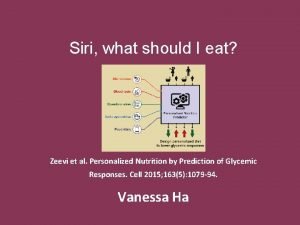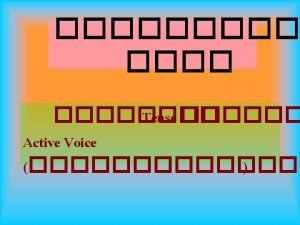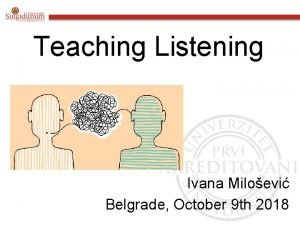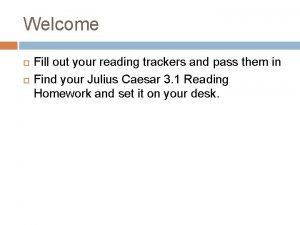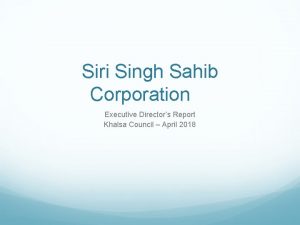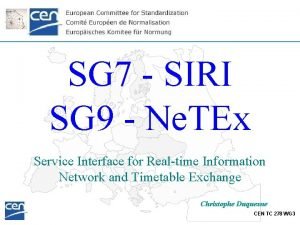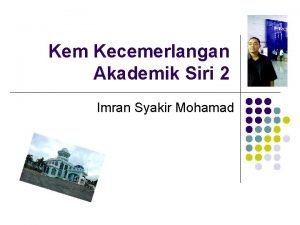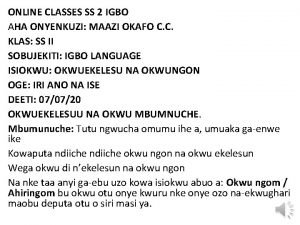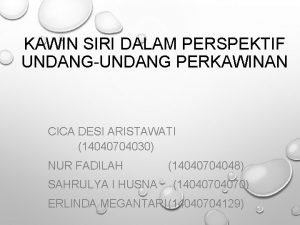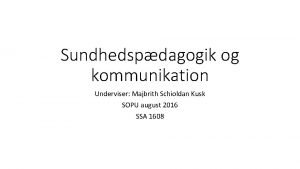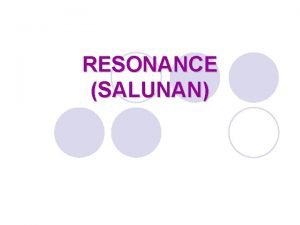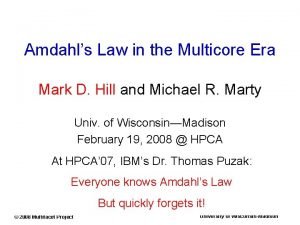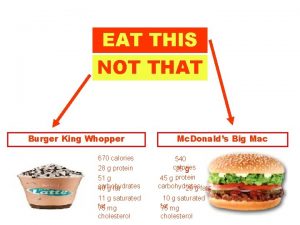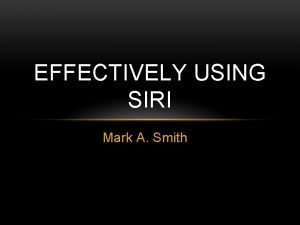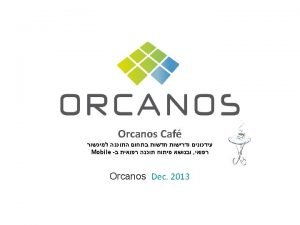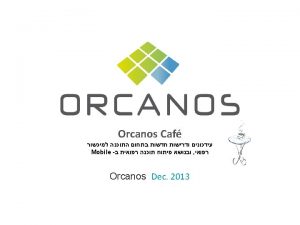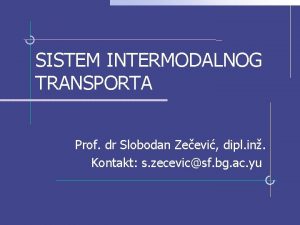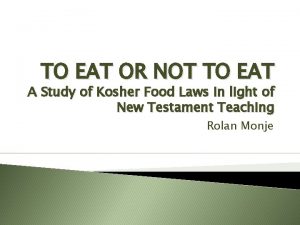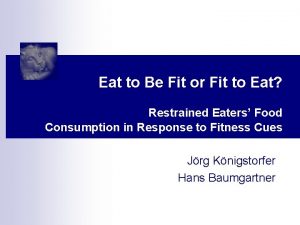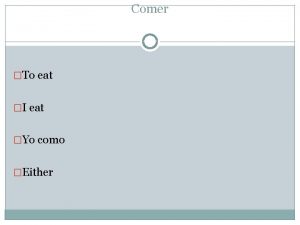Siri what should I eat Zeevi et al
































- Slides: 32

Siri, what should I eat? Zeevi et al. Personalized Nutrition by Prediction of Glycemic Responses. Cell 2015; 163(5): 1079 -94. Vanessa Ha

What is Postprandial Glycemic Response? Jenkins et al. BMJ 1980; 281(6240): 578– 580.

PPGR and Survival Brunner et al. Diabetes Care 2006. 29: 26 – 31.

PPGR and Oxidative Stress High PPGR High post-prandial blood glucose Oxidative Stress ↑ Disease Risk ↑ Cardiovascular Risk Ceriello. Diabetes 2005. 54: 1– 7.

Diet and PPGR Food Carbohydrate Quantity and Quality • Carbohydrate Quantity -> Carbohydrate Loading • Carbohydrate Quality -> Glycemic Index/Glycemic Load Postprandial Blood Glucose

Study Purpose To develop an algorithm that can predict individual postprandial glycemic responses

In the Media

Study Objectives Study 1 1. To conduct an observational study of 800 individuals to characterize the variability of postprandial glycemic response (PPGR) Study 2 2. To develop an algorithm that integrates blood parameters, dietary habits, anthropometrics, physical activity, and gut microbiota that can be used to predict PPGR Study 3 3. To conduct a randomized controlled trial that compared a dietary intervention based on the algorithm to lower PPGR to a dietary intervention that predicted high PPGR on PPGR and alterations to gut microbiome

Study 1 Characterization of postprandial glycemic response

Methods Eligibility Criteria • individuals aged 18– 70 • not diagnosed with T 2 DM Study Design • Participants were blinded to the results of CGM Pre-study Period Continuous Glucose Monitoring (CGM) Period 0 d • FFQ • lifestyle and medical questionnaires • anthropometric measures • blood tests • single stool sample • Given standardized breakfast every day • Recorded using smartphone website: • food intake • exercise • sleep 7 d

Results- Characteristics of Participants Representative of the adult non-diabetic Israeli population as well as Western adult nondiabetic population

Results- Postprandial Glycemic Response Intra-variability R = 0. 77 for glucose R = 0. 77 for bread with butter R = 0. 71 for bread, p < 10 -10 -variability to the identical food is small in the same person -variability to the identical food is big in different people Inter-variability

Study 2 Development of the Algorithm

Methods Algorithm Development- Decision Tree

Methods Algorithm Development- Predictors 1. Meal features- alcohol (g), caffeine (mg), carbohydrate (g), dietary fibers (g), energy (Cal. ), fat (g), protein (g), sodium (mg), sugars (g), water (g), carbohydrates-to-fat ratio 2. Lifestyle features- time to next and last exercise and sleep; amount of water consumed one hour before and in the two hours following the meal; total amount of carbohydrates consumed in the 3, 6 and 12 hours prior to the meal; total amount of calories consumed in the 2, 3, 6, and 12 hours prior to the meal; total amount of fibers consumed 12 and 24 hours prior to the meal; and the hour of the day in which the meal was consumed 3. CGM-derived features- i. AUC and glucose trend of 1, 2, and 4 hours prior to the meal 4. Clinical features- blood test results 5. Personal features - age, sex, smoking habits, and self reported hunger, physical activity, stress levels and defecation routine 6. Microbiome features - relative abundances of 16 S r. RNA based phyla existing in more than 20% of the cross-validation training cohort; relative abundance of the 30 KEGG modules, 20 metagenome-based species relative abundances selected similarly to the KEGG modules; 10 PTRs; Percentage of reads mapped to host genome, gene-set database, and database of full genomes

Methods Algorithm Validation q Internal Validation • standard leave-one-out cross validation scheme • Whereby PPGRs of each participant were predicted using a model trained on the data of all other participants q External Validation • Recruited independent cohort of 100 participants and their PPGRs were predicted using the model trained only on the main cohort

Results Study’s Algorithm R= 0. 68 p-value< 10 -10 R= 0. 70 p-value< 10 -10 Carbohydrate Counting R= 0. 38 p-value< 10 -10 Calories R= 0. 33 P-value< 10 -10

Study 3 Dietary Intervention

Objective q whether personally tailored dietary interventions based on the algorithm could improve PPGR and cause changes to the gut microbiome over 1 -week period Participants q n= 26 • 12 individuals in the predictor arm and 14 in the expert arm • Eligibility Criteria: 1) individuals aged 18– 70; 2) not diagnosed with T 2 DM

Methods Study Design • blinded randomized controlled trial Good Diet (low PPGR) 0 d Pre-study Period • • • FFQ lifestyle and medical questionnaires anthropometric measures blood tests single stool sample Bad Diet (high PPGR) 0 d Bad Diet (high PPGR) 7 d 7 d Good Diet (low PPGR) 0 d Good Diet (low PPGR) Bad Diet (high PPGR) 0 d “Predictor Arm” Diets were determined by algorithm 14 d Bad Diet (high PPGR) 7 d Good Diet (low PPGR) 7 d • • 14 d Continuous Glucose Monitoring Daily Stool Collection 14 d “Expert Arm” Diets were picked by a dietician + researcher

Results- PPGR Individual Data Average Data Overall one either the predictor or expert arm, the bad diet significantly had higher PPGR than the good diet (p< 0. 05)

Results- PPGR

Results- Microbiome Statistically significant increase(p< 0. 05) Statistically significant decrease(p< 0. 05) The abundance of several types of bacteria changed when comparing the bad diet to the good diet

Discussion

Conclusions • First study to develop a personalized algorithm to predict PPAR • Using personal and microbiome features enables accurate PPGR prediction • Prediction is accurate and superior to the current gold standard, carbohydrate counting • Short-term personalized dietary interventions successfully lower PPGR • Future Directions: Can algorithm be used on other ethnic populations? Are there other predictors that can be added to the algorithm to further increase accuracy? What are the long-term metabolic consequences of changing microbiome by changing PPAR? • Larger and longer high-quality research is needed!

Time for Discussion Thank you!

Extra

Participant Characteristics Statistically non-significant difference

Results Glucose Fluctuations Max PPGR

Glycemic Index Limitations: • Number of factors effect the GI

Limitations

Postprandial Glucose and Disease Risk Ceriello. Diabetes 2005. 54: 1– 7.
 Siri what should i eat
Siri what should i eat I eat, you eat, he eats
I eat, you eat, he eats People buy me to eat
People buy me to eat I would rather eat potatoes than eat rice yay or nay
I would rather eat potatoes than eat rice yay or nay Best diet for basketball players
Best diet for basketball players Jpl siri
Jpl siri Siri singh sahib corporation
Siri singh sahib corporation Siri dahl personal assistant
Siri dahl personal assistant Siri nessa bjørnevik
Siri nessa bjørnevik V rovnorodom prostredí sa svetlo šíri
V rovnorodom prostredí sa svetlo šíri Sat siri khalsa
Sat siri khalsa Siri what time is it
Siri what time is it Siri hongseth
Siri hongseth Nikah siri dalam islam
Nikah siri dalam islam Ujian personaliti warna otak
Ujian personaliti warna otak Omumaatu ahiriokwu
Omumaatu ahiriokwu No vuela y tiene un ala no es un camión y hace cran
No vuela y tiene un ala no es un camión y hace cran Nikah siri adalah
Nikah siri adalah Laplas qonuni formulasi
Laplas qonuni formulasi Bjarne bruun jensen sundhedsbegreb
Bjarne bruun jensen sundhedsbegreb Siri what time is it
Siri what time is it Salunan
Salunan What did they eat on ve day
What did they eat on ve day Figurative language examples hyperbole
Figurative language examples hyperbole And eat
And eat What do elephants eat
What do elephants eat You mustn't smoke in the hospital
You mustn't smoke in the hospital Eat meals that are nutritious agree or disagree
Eat meals that are nutritious agree or disagree Dont eat in class
Dont eat in class Do owls eat
Do owls eat Monkeys eat peeled bananas chemistry
Monkeys eat peeled bananas chemistry Fish burger calories
Fish burger calories Instinct motivation
Instinct motivation
